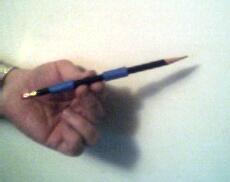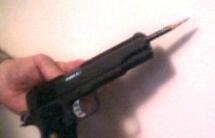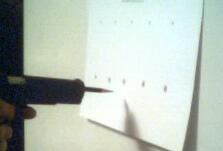

*Pistol Training Techniques*
When I was training years ago to be a pistol team coach our instructors (President's 100 pistol shooters) showed us a couple of tricks to use in training people to shoot handguns better. One was called "ball and dummy", another was "shoot the pencil", a third was dry-fire, and the fourth was to use a .22LR pistol. These techniques can be used to train new shooters as well as improve the skills of more experienced shooters. They are primarily used to improve technical skills or technique that then can be applied in any pistol shooting situation.
Ball and Dummy is where shooters are paired up on the line. We would take turns being the shooter or the coach. The shooter would step back from the line and turn and face away from the range, while the coach would step forward and "load" the gun with a magazine filled with both ball rounds and dummy rounds (no active primer or powder, one technique is to take a pencil eraser that fits in the primer pocket and super gluing it in place) or ball and snap caps in no particular order, then chamber from the top of the magazine and putting the weapon on safe place it on the table pointing down range. The shooter would then turn around and assume a good shooting position and take the pistol into their hand, take off the safety and proceed to engage the target. If the round went off they prepared to engage the target again. If it did not fire, it was mostly a surprise and you could see if they were anticipating recoil (the gun would tip up a little as if in recoil), jerking the trigger (the barrel would "jerk" down and away from the shooting hand) or pulling the trigger (the barrel would "jerk" towards the shooting hand). If it did not fire the shooter would not rack the slide and try again, the coach would chamber the next while the shooter had their back to the line (the shooter did not know whether or not the gun had a live round in the chamber, but thought so). At first the shooter would get very few live rounds, later the number of live rounds would increase, the "proof" of this method shows up quickly on the target. This was very helpful in getting the shooter to see what they were doing wrong.
The Ball and Dummy can be modified and applied to a revolver by the coach loading all chambers with either ball or empties. The shooter can then engage the target (either in double action or single action) and will not see what is rotated into battery to fire.
Shooting the pencil is an aid to training I have used to great effect
with both experienced shooters and rookies. To do this you take a regular
number 2 pencil with an eraser and "size" it to fit just barely loose in
the barrel of the pistol you are practicing with. Of course this means
you can only use this in a caliber larger than the pencil used. I have
used this method with 9mm/38/357 .40 and .45 cal pistols effectively. First
make sure that your pistol is empty and the chamber is clear. Then take
your pencil and wrap a little masking tape around the pencil in two places
one about an inch up from the eraser or a little more (so you don't get
hung up on the chamber mouth) and another about an inch or so short of
the end of the barrel until it fits well but is still loose in the barrel.
Loose enough to fall out when tipped down, but enough so it doesn't wobble
a lot. The pencil should protrude an inch or two out the end of the barrel
when in contact with the breech face to be most effective.


Then take a sheet of paper and draw a number of small 1/8" or smaller
circles or little silhouette targets or whatever you want to "aim" at.
Tape the paper up on a wall with "cork board", dart board or something
that you won't mind poking some little holes in. Then holding your pistol
in your shooting hand pull back the hammer or appropriately charge it and
tip up to allow the pencil to fall back against the breech. Then step forward
until your are within an inch or two of the pencil touching the paper target.
Sight in on the first "target" spot and carefully engage the target. The
pencil will be shot out of the barrel the short distance to the paper target
and put a mark on the paper. Charge the weapon again and tip it up to let
your pencil fall back to the breech face and do it again. You will begin
to create a group of pencil marks below the aiming point. Our goal was
to get those groups smaller and smaller working toward the magical single
small dot. Remember to sharpen your pencil periodically between strings
as needed, if the pencil gets to short you may have to set up another.
We could get a 30 minute session or two without having to sharpen, depending
on the "target" backing. This assists in your "technical" training to help
you in consistent sight alignment, trigger squeeze and follow-through.

Dry-fire is useful but really should be done with a snap cap in the chamber rather than on an empty chamber. In fact some manufacturers, gunsmiths and owners frown on dry-firing at all. I have used snap caps and dummy rounds I made up with pencil erasers fitted into the primer pockets and painted the bullets red or blue to indicate dummy loads. This training practice allows you to draw from concealed carry and engage a "target" on the wall without damaging the wall with little holes. As you squeeze the trigger you can follow the sights to see if you are engaging the target properly as the hammer falls and ensure proper follow-through. Be extremely careful not to have any "live ammo" around when doing this and never keep your live and dummies stored together.
Finally the "last trick" we used extensively was to use .22 pistols and move back and forth to help a shooter "settle down" from the recoil of the heavier weapons. We would always start our training session with the .22 pistols and then progress to the larger weapons, then when we found groups getting larger would move back to the .22s to see what the shooter was doing wrong. Then end the day with a couple targets of just .22. The result was a much more consistent shooter.
Using these techniques we trained in both "Bullseye" and "Combat" matches.
These techniques work in training people who have not shot before and those
who have. They are not just for target shooting, the techniques learned
transfer very nicely to engaging any target with a pistol. Most require
an assistant or "coach", we would alternate between being the coach and
shooter and help each other. I used all of these techniques in the pistol
teams that I trained over the years I spent playing Army. Of the four teams
I trained, each did well enough to place in the top three for every event
shot in Division and Corps competitions. Give them a try...they work!
Tailgunner
All materials at this site not otherwise credited are Copyright © 1996 - 2002 Trip Williams. All rights reserved. May be reproduced for personal use only. Use of any material contained herein is subject to stated terms or written permission.